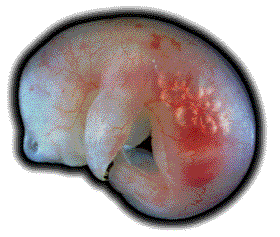
| ||
 | ||
 |
Baby mouse leaves scientists breathless
|
DANIEL McCABE | For an animal that wasn't even supposed to exist anymore, the Julia Creek dunnart is causing a lot of excitement. Working with Australian scientists, physiology professor Jacopo Mortola has discovered that this marsupial mouse can do what no other mammal in the world can do -- it can breathe through its skin.
To be more precise, it can breathe through its skin as a newborn. Once the animal becomes older, it gradually develops the same sort of respiratory system that all mammals have. Mortola says that the animal was thought to be extinct as recently as eight years ago when Professor Patricia Woolley from La Trobe University began to do a little detective work. "She suspected they might still be alive after looking at owl pellets and droppings from other predators. She thought she recognized bones and skeletal remains [as belonging to Julia Creek dunnarts]," says Mortola. Woolley deduced the areas where the birds were most likely to have dined on the animals ("I had to think like an owl," she told ABC News) and set up some traps. Her hypothesis bore fruit and she proved that the mice weren't so extinct after all. She was the first scientist to see a live Julia Creek dunnart in 20 years. She brought some of the animals into her lab and set up a colony where about 50 of the animals currently live. This is where Mortola enters the tale. "I came into this purely by chance." He was visiting La Trobe last summer to work with a colleague of Woolley's on another project entirely. Woolley invited Mortola, an expert on respiratory systems in newborns, to see what he thought of baby Julia Creek dunnarts. "They didn't seem to be breathing in any kind of conventional way," says Mortola, who noted that the animals weren't yet able to contract their respiratory muscles. " I couldn't see their chests expanding or collapsing. But they were alive, so the air was getting in somehow." This led Mortola, Woolley and La Trobe's Peter Frappell to consider that the unthinkable was thinkable -- that the animals were breathing through their skin. Mortola says it's not unusual to see cold-blooded animals -- some types of frogs and salamanders, for instance -- that have the ability to take in air through their skin. But their bodies are built in a radically different way than mammals'. "For many years, scientists believed that [the ability to breathe through skin] just wasn't possible for mammals." For one thing, mammals require a lot more oxygen than cold-blooded creatures. Warm-blooded animals tend to be much more active and need much more oxygen to sustain that activity. You can take in a lot more air with a good pair of lungs and a mammalian respiratory system than you can through skin. Another biological fact that made the idea of mammals breathing through their skins unlikely is that, to pull it off, you would require a thin, very permeable type of skin. Cold-blooded vertebrates can exist in water much of the time and they can use the water to help regulate their body temperature. Their skin can afford to be thin. Warm-blooded animals need relatively thick skins to protect themselves from dehydration. Once the notion that the baby mice were breathing through their skins entered the scientists' heads, they acted on it right away. "We began taking measurements that very night," Mortola says. So how do the newborn Julia Creek dunnarts pull off the trick? For one thing, they're extremely small -- just a bit bigger than a grain of rice. Due to their size -- the baby dunnarts are among the tiniest newborn mammals around -- they don't require a great deal of oxygen. The newborn dunnarts have a relatively high body surface to body mass ratio. "If you want to take advantage of your skin [for breathing], it helps to have a relatively large amount of skin for your body mass," posits Mortola. The bigger you are, the less skin surface you have, relative to your body mass. The animals also exist for the first portion of their lives in a pouch on their mothers. That keeps them snug and warm and allows them to have very thin skin. "Their skin is extremely permeable. It's so transparent, you can see the internal organs," says Mortola. Once the dunnarts get older, their systems evolve. Right after birth, they get all their air through their skin. By three weeks, they receive about 50 per cent of their oxygen through their skin. What will the discovery mean for the future? Is the animal simply a freak of nature or will the newborn dunnart's unique ability change the rules in terms of how scientists approach the whole idea of breathing? "It certainly is a zoological curiosity," says Mortola. He, Woolley and Frappell published their finding in a recent edition of Nature. "It's also a really unique opportunity to study a mammalian system unlike any other." Mortola says the dunnart presents a chance to look at the interrelation between metabolic rates, body temperature and pulmonary ventilation in a way they've never been examined before in a mammalian system. The link between the way we breathe and the way we use up our body's energy still isn't fully understood. "Is this a tight genetic link that exists from day one or does it develop later on?" wonders Mortola. That the newborn dunnarts breathe in such an unusual manner is an exciting find, he says. "This is a new model, an opportunity for us to think about old questions about respiratory control in an entirely new way. It's been given to us on a silver platter by nature quite unexpectedly."
|
|
| |||||